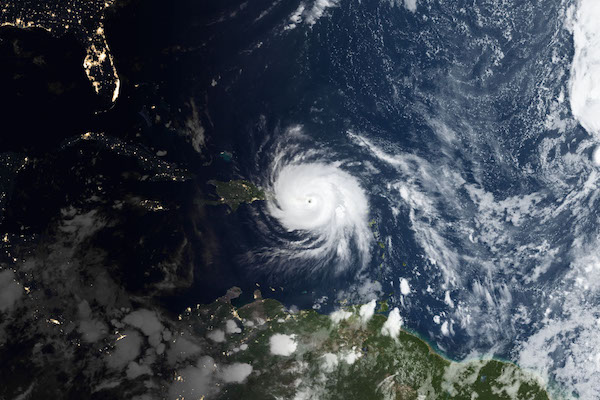After the storm
Lower-cost air quality monitors measured pollutants in Puerto Rico after Hurricane Maria
Kathryn Anne Quelle
Nov 19, 2018

Source: NASA Earth Observatory
Hurricane Maria, September 20, 2017.
In late September 2017, Hurricane Maria devastated Puerto Rico. Shortly after the hurricane hit, more than 90 percent of the US territory lacked access to electricity. Even three months later, half of the island still did not have power, and power outages were frequent, forcing many people to rely on power generators. In a recent study, Carnegie Mellon University and University of Puerto Rico-Rio Piedras (UPR-RP) researchers showed that these generators increased air pollution in the San Juan Metro Area.
To power the generators after the hurricane, the US Environmental Protection Agency (EPA) granted Puerto Rico a waiver from ultra-low sulfur diesel (ULSD) requirements until mid-November 2017 and allowed Puerto Rico to use diesel fuel with higher sulfur content until they depleted the existing stocks. The EPA prohibits diesel fuel with higher sulfur content because the fuel is strongly correlated with emissions of fine particulate matter (PM)–a known carcinogen. The widespread use of non-ULSD fuel can also increase concentrations of sulfur dioxide (SO2), which is a precursor to PM and causes migraines and reduces heart health.
In addition to taking out much of the island’s electricity, Hurricane Maria also damaged Puerto Rico’s existing air monitoring network and no air quality data was collected for the first two months following hurricane impact. Certain reports attribute thousands of additional deaths after hurricane impact to Hurricane Maria, and some of those deaths may have been due to hurricane response-related air quality degradation.
The results also strengthen the case for backup power sources that are not based on fossil fuels as part of disaster response plans.
R. Subramanian, Research scientist, Carnegie Mellon University
Carnegie Mellon and UPR-RP researchers started monitoring Puerto Rico's air quality in late November 2017. To monitor air quality in Puerto Rico, the researchers deployed four lower-cost Real-time Affordable Multi-Pollutant (RAMP) monitors and one black carbon (BC) monitor in the San Juan Metro Area. The RAMPs, which Carnegie Mellon developed in collaboration with SenSevere, operate on low-power solar panels and can measure carbon monoxide (CO), nitrogen dioxide (NO2), ozone (O3), nitric oxide (NO), and SO2.
In the first month of collection, the RAMPs measured SO2 concentrations that exceeded the EPA's threshold approximately 80 percent of the time. On several days, SO2 concentrations exceeded 200 ppb, well over the EPA’s threshold of 75 ppb. The researchers also found that SO2 concentrations were highly correlated with other harmful substance concentrations such as CO and BC, which is a significant component of fine particulate matter.
The study’s overall goal was to collect information that can “guide future responses to similar disaster scenarios.” The study’s principal investigator, Carnegie Mellon’s Mechanical Engineering Research Scientist R. Subramanian, commented on the results, saying, “The high levels of sulfur dioxide and carbon monoxide were unexpected, and show that the RAMPs can provide valuable information about potential air pollution-related health hazards in real-time. The results also strengthen the case for backup power sources that are not based on fossil fuels as part of disaster response plans.”
The findings were published in ACS Earth and Space Chemistry. Locally, Carnegie Mellon's Center for Atmospheric Particle Studies also deploys RAMPs around Pittsburgh, Pa. neighborhoods to help residents understand their exposure to air pollution.
Media contact:
Lisa Kulick
lkulick@andrew.cmu.edu